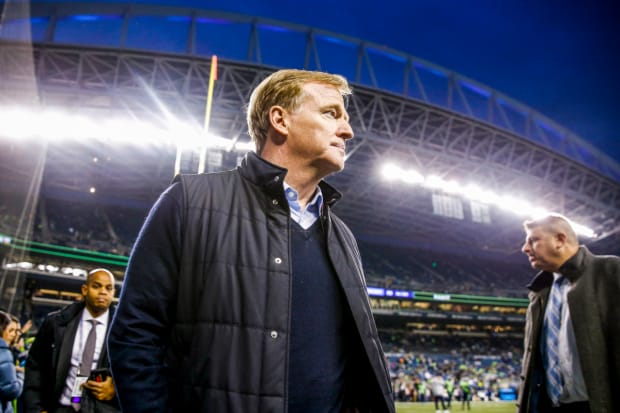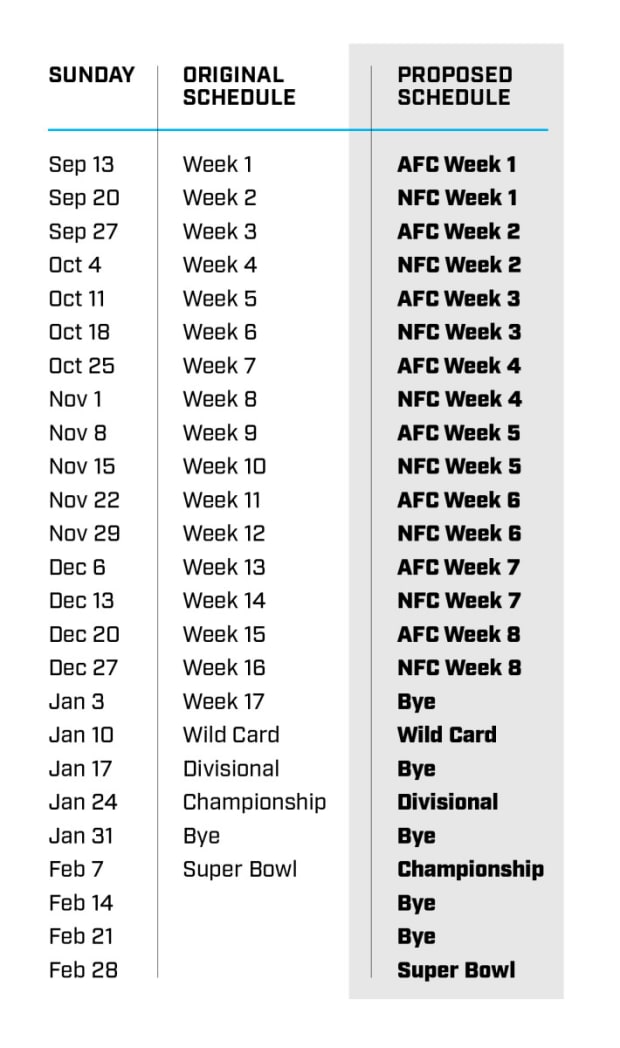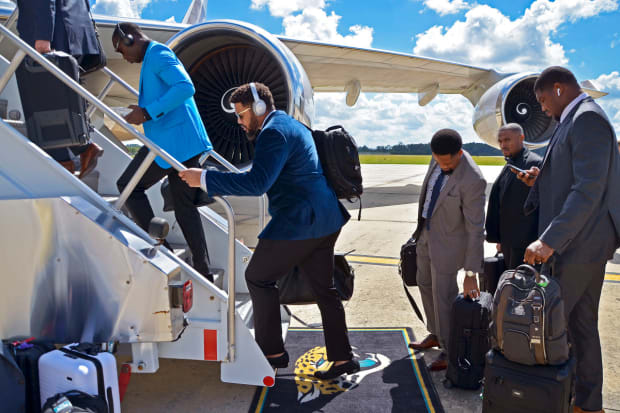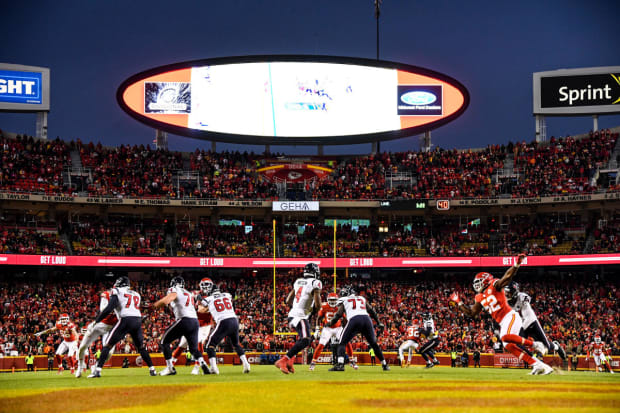It’s time for the NFL to consider a much different approach to the 2020 season, one that means fewer total games, but just as much TV exposure and—most importantly—a potentially safer way to play football during a pandemic.
For months now, we have all talked about how the NFL has had the benefit of time. Our pro football overlords had a chance to watch other sports leagues, within or without a bubble, begin or resume their seasons amid the COVID-19 pandemic. If the people who run the NFL are smart, they may conclude—two weeks into MLB’s season from hell—that they’ve seen enough. It’s time to seriously consider a serious overhaul to the 2020 NFL schedule.
I’m not here to be an alarmist. I’m here to be a pragmatist. I know that statements like this, grand declarations about what our response to the novel coronavirus should be, have become polarizing and politicized. I know there are people who think preaching caution is somehow a sign of weakness, and that sports writers who suggest reactionary changes are rooting against the return of sports.
I promise you: I want to plop my butt on the couch September 13 and watch seven hours of NFL Red Zone as much as anyone. I want to set my fantasy lineup and argue about power rankings, quarterback controversies and horrible replay reviews.
But within the last week, we have seen a head coach test positive and two starting quarterbacks go on the COVID-19 IR. Before that, the Bills had to send their rookies home before the rest of the team even made it through testing. Dozens of players have opted out entirely, making clear they are concerned about playing the season as currently scheduled.

Outbreaks on multiple MLB clubs and postponements of entire weeks’ worth of games seem to be proving that while sports returning in a bubble are doing O.K., the bubble-less are in real trouble. Anyone following along as colleges cancel a few more games every day could come to the same conclusion. MLB is dealing with positive tests, players’ learning about games being postponed via Twitter, inconsistent protocols for canceling those games and more. And an NFL season with many fewer games per team and much less schedule flexibility midstream could be in for an even greater challenge once positive tests start coming.
It’s a near-certainty that as we get closer to Week 1, the NFL will only be faced with increasingly difficult decisions, and it may be more prudent to make a sweeping decision now rather than wait until it’s right up against a harder deadline—when it’s perhaps too late to do anything drastic. MLB fought over money to the very last day, forcing it to arrive late to the party on issues like health and safety, and the logistics of actually putting the season together. The NFL can’t afford (and yes, we’re also talking about money here) to repeat that same mistake.
In a world where we are constantly evaluating best-case and worst-case scenarios, at some point it makes sense to cut your losses. Rather than going into a season held together with Scotch tape, the NFL could go in with a plan it feels more confident in, with enough lead time to prepare for it fairly and, in the case of the revised TV schedule, as profitably as possible.
But we all know it’s a faux pas to point out a problem without proposing a solution, so here’s the best I’ve come up with. This is a plan to preserve as much of the 2020 season as we can, in a way that will: A) be more feasible in our current climate; B) preserve enough competitive balance and normalcy that we can feel O.K. about crowning a Super Bowl champion; and C) hopefully make the NFL universe enough gobs of money for everyone to find the exercise worth the trouble.
* * *

Each team plays eight games. The first step is simple: Chop each team’s schedule in half. The main benefit here, beyond limiting the number of times different teams are coming into contact with each other, is for each team to play all its games two weeks apart. The MLB season has been KO’d by the fact that they are playing so frequently. It’s hard to handle false positives and lagging test results when there is another game the next day. The NFL has a luxury of more spaced-out games anyway, and this plan is much more in line with the recommended quarantine period. If a player tests positive and has to isolate, he would miss only one game.
I’d suggest each team play six division games and two other intraconference matchups (for reasons I’ll get to in a minute).
Weeks alternate between AFC and NFC. That way, we get eight football games every week. (I’ve eliminated bye weeks since teams already have so many built in.) We would all miss those wild Sunday slates when seven games are going on at once, but it doesn’t sound like we’ll be going to sports bars with dozens of TVs anyway.
Our Albert Breer has reported that Super Bowl host cities are required to block off the dates for a few weeks after the Super Bowl in case it has to move back. They could move the Super Bowl from Feb. 7 in Tampa to as late as Feb. 28, so we’ll take advantage of that to build spacing into the playoffs, too.
Here’s a look at what the new schedule could be. You could even have two bye weeks leading up to the Super Bowl so that players could isolate in a bubble for a full 14 days before the big game, to hopefully limit the number of players who would be held out. This at least reduces the chance of positive tests popping up at the last minute before the Super Bowl.

Play every game at night. On June 30, Mike Florio reported that some teams were considering flying to road contests on game day to avoid having to stay in a hotel. The response was swift, including Tyrann Mathieu’s quote-tweeting Pro Football Talk’s original tweet simply with: “Hell Nah.” I totally understand the concerns about injury risk, hopping on a football field immediately after hopping off a flight. And for a 1 p.m. ET kickoff, it’s also literally impossible in many cases.
But if you concede that keeping players out of hotels and delivering them as directly as possible from their own team facility to the visiting stadium is of paramount importance, one way you could fly on game day is if the 2020 season consisted exclusively of night games.
And even if you ignore the idea of flying players in on game day, the all-night schedule could still make a lot of sense for TV networks. We all know the truth: The money from TV networks is one of the top reasons they are attempting to go forward with this season at all. So let’s look at what happens if you play every game at night.
If we have eight games per week, the league can spread out among four days: Saturday, Sunday, Monday and Tuesday. (Saturday could become Wednesday if the NCAA magically pulls off a college football season, but many folks don’t think it looks promising.) Playing four days a week is a great way to keep all four TV partners—CBS, Fox, NBC and ESPN—happy. You could have two games on at once, or cobble together doubleheaders like the annual Week 1 Monday night double. And if you had doubleheaders, you could have teams from the Eastern and Central time zones (also the teams likely to have traveled less) kick off first.

Yes, Fox and CBS might not like the thought of losing their vaunted Sunday slots. But it is possible to have four days a week of doubleheaders, thus putting all 128 regular-season games in stand-alone TV windows. That could be a bonanza of ratings and ad dollars to offset the Sunday-afternoon loss. Imagine a world where every single game involving the Chiefs, Cowboys, Patriots, Ravens, Steelers and Packers were on TV with no other NFL game competing for air time. I think the networks would take it. Yes, we’d get some dull games on some days, but we’d be talking about a year in which 90 or more of the top-100-rated TV shows are live NFL games.
And spreading games out to four days a week works because there is extra time in between games. In our current environment, teams get the short end of the stick when one team has an extra day of rest compared with its opponent. That competitive imbalance is alleviated quite a bit when the difference is between 12 days and 14 days of rest.
It bears repeating: This plan is the only way to accommodate having players fly on game day and avoid hotels completely, but it works even if teams travel the day before instead. We’d lose our classic NFL Sundays, but we’d gain a lot of prime-time football and the chance to theoretically watch every game of the abbreviated season in real time.
Extra conference games. The most prudent thing to do would be to schedule each team’s nondivision games against the teams geographically closest to them. Rams vs. Chargers; Jets vs. Giants; Ravens vs. Washington; etc. MLB dispensed with the usual AL/NL schedule format for 2020 so that teams could play the corresponding division in the opposite league, and people got over it because it made sense in this environment. It was also deemed better than nothing (though that’s what we still may be left with at some point, anyway). But I think for competitive reasons, and to help seed the playoff field, you could justify making these two games intraconference. Also, that’s the only way to build a schedule with the conferences alternating weeks instead of mixing them together.
You could still pair up teams that are as geographically close as possible. In some regions of the country, that would be easy. In others it would clearly be tougher. But there’s no reason to make Seattle fly to Tampa, Charlotte or Philly (or make those teams fly to Seattle) when you could have Seattle’s extra games come against somewhat closer teams like Dallas, Minnesota or Green Bay. That’s especially true if teams are flying on game day. It’s not perfect, but you can do as well as you can. If San Francisco’s one nondivision road trip is to Chicago or New Orleans, at least those cities are only two time zones away instead of three. Either trip would at least be marginally better than flying to D.C. or Atlanta. It’s not ideal, but it’s better than randomizing things or following the typical step of using last year’s standings to determine those games.
Two teams from each division make the playoffs. I am mostly against expanded playoffs (including the 7-seed set to enter the fray this year), but I get why it makes sense in the shortened season above. And yes, if you’re chopping 128 games from the regular season, revenue becomes a justifiable reason to add two extra playoff games.
I am proposing, one time only, to put two teams in each division into a tidy 16-team field. With such a high percentage of games played within the division, that seems like a fair and easy way to pick the playoff participants. (MLB went with a similar route when it expanded its playoffs, guaranteeing each division two spots, plus two wild cards in each league.) Crucially, with regard to the NFL calendar, you can add two more teams without adding any additional weeks. So I won’t take any additional wild cards beyond each division’s top two like MLB did, but in a season when every team has a bye week before the playoffs already, I will ask No. 1 seeds to host an 8-seed on wild-card weekend.
I get that there are some issues with a rigid two-teams-per-division format. It may seem unfair to teams in tough divisions like the NFC West, where a third-place team could figure for a wild card in a normal year. But again, this is all so fraught, anyway, and with such wholesale changes, that it’s impossible to be completely fair to everyone. So if the team that gets screwed this year is the hypothetical third-place team that would otherwise sneak into the playoffs as a 6- or 7-seed, I think people can get over it.
There would be the issue of tiebreakers, which may be more necessary with a shorter season. Beyond the obvious (head-to-head record then division record) maybe this year we’d settle ties within the division with … point differential in division games? I don’t always love point differential as a tiebreaker, but it would make games more exciting throughout the season. All 60 minutes would matter every week, even after the outcome is decided. We’d see teams with the lead running up the score or teams trailing by multiple touchdowns driving for those garbage-time points. (More two-point conversions? More octopus opportunities?) Let’s say the Chiefs run away with the AFC West. The last few minutes of every Broncos, Chargers and Raiders division game would get very exciting if they are in a fight for second place that may come down to a tiebreaker scenario.
* * *

As with everything in 2020, there would be more to sort out later. But given the gist of the plan above, I think we’d survive, right? It’s not the season we all want, but it may be the best possible season we could get. I know there are a million obstacles in the way, and chief among them is simply the human brain—the most comfortable approach is always to root for Plan A until it proves itself untenable. Inertia is a powerful force, and there is little to no chance the NFL would make such a drastic change until or unless it was absolutely necessary. NFL fans would probably rather point out the differences between the football and baseball seasons, or simply blame Rob Manfred’s leadership, since that’s fashionable, rather than acknowledge the likelihood that the NFL is attempting to walk across just as high a tightrope, with perhaps even less of a safety net given that MLB is a league better suited to shrugging off missed games and final standings where teams have played unequal numbers of games.
And even if the league did implement this plan tomorrow, and then successfully made it all the way through 128 regular-season games and 15 playoff games, culminating in Super Bowl LV on Feb. 28, it would still take some mental gymnastics to assess retroactively whether such a radical approach was necessary. We’d likely have no way of knowing if the NFL could have survived the gantlet that is the current schedule, or how the season could have been affected by a normal amount of travel, hotel stays and days between games. That’s one of the scary parts of taking a leap like this—if you can’t prove it was necessary, you may not be able to justify it after the fact.
On the flip side, it is possible the NFL will play its 16-game season with no interruptions, few positive tests and no canceled games. In that case, this old column would survive on the internet and I would be asked to eat a large helping of crow. But, right now, on Aug. 6, how likely does that seem? And is it worth the risk?
The NFL wants to make money, provide entertainment and play a season that allows fans and players to care about the stats, game results and champions that will enter the record books. Of course. But the league’s chief priority has to be the health and safety of its players, coaches, trainers and other staffers who help make the season run (and, since we’re discussing a contagious disease, the health and safety of their families). I know that cutting the number of games in half does that. And making a bold decision ahead of time could be the best way to preserve all that other stuff and avoid the total disaster—pulling the plug on a season—that MLB may soon face.
Is it my preference to see the season above? No. I would love nothing more than for life to go back to normal with full stadiums and full TV windows. But 2020 has made a habit of taking what you’re rooting for and throwing it down the drain. And what’s above sounds a lot better than seeing the NFL go through what MLB and college football are currently going through. Or the alternative, one that I know people don’t want to think about, one that they should be bracing for even if they can’t wrap their heads around it: no pro football at all.